Urban Heat Island Mitigation: GIS-Based Analysis for a Tropical City Singapore
Abstract
:1. Introduction
2. Technical Review
2.1. Methodologies to Mitigate UHI
2.2. Greeneries
2.3. Green Buildings
3. Materials and Methods
3.1. Overview of Data Source and Methodologies
3.2. GIS Based Methodology
3.3. Data Processing
- Weather data
- Green Marked building data
- Park data
3.4. Spatial Analysis
4. Results
4.1. A Summary of the Results
4.2. National Parks and Gardens
4.3. Skyrise Green Rooftops
4.4. Density of Green Mark Building Clusters
4.5. Temperature
4.5.1. Annual Temperature in 2019
4.5.2. Annual Percentage Temperature from 2017 to 2019 in Singapore
5. Discussion
6. Conclusions
Supplementary Materials
Author Contributions
Funding
Institutional Review Board Statement
Informed Consent Statement
Data Availability Statement
Acknowledgments
Conflicts of Interest
References
- Aflaki, A.; Mirnezhad, M.; Ghaffarianhoseini, A.; Ghaffarianhoseini, A.; Omrany, H.; Wang, Z.-H.; Akbari, H. Urban heat island mitigation strategies: A state-of-the-art review on Kuala Lumpur, Singapore and Hong Kong. Cities 2017, 62, 131–145. [Google Scholar] [CrossRef]
- Mirzaei, P.A. Recent challenges in modeling of urban heat island. Sustain. Cities Soc. 2015, 19, 200–206. [Google Scholar] [CrossRef]
- Morris, K.I.; Salleh, S.A.; Chan, A.; Ooi, M.; Abakr, Y.A.; Oozeer, Y.; Duda, M. Computational study of urban heat island of Putrajaya, Malaysia. Sustain. Cities Soc. 2015, 19, 359–372. [Google Scholar] [CrossRef]
- Oke, T.R. The energetic basis of urban heat island. J. R. Meteorol. Soc. 1982, 108, 1–24. [Google Scholar] [CrossRef]
- Yang, L.; Yu, K.; Ai, J.; Liu, Y.; Lin, L.; Lin, L.; Liu, J. The Influence of Green Space Patterns on Land Surface Temperature in Different Seasons: A Case Study of Fuzhou City, China. Remote Sens. 2021, 13, 5114. [Google Scholar] [CrossRef]
- Arifwidodo, S.; Chandrasiri, O. Urban Heat Island and Household Energy Consumption in Bangkok, Thailand. Energy Procedia 2015, 79, 189–194. [Google Scholar] [CrossRef]
- Kolokotroni, M.; Giannitsaris, I.; Watkins, R. The effect of the London urban heat island on building summer cooling demand and night ventilation strategies. Sol. Energy 2006, 80, 383–392. [Google Scholar] [CrossRef]
- Garzón, J.; Molina, I.; Velasco, J.; Calabia, A. A Remote Sensing Approach for Surface Urban Heat Island Modeling in a Tropical Colombian City Using Regression Analysis and Machine Learning Algorithms. Remote Sens. 2021, 13, 4256. [Google Scholar] [CrossRef]
- Zheng, Y.; Li, Y.; Hou, H.; Murayama, Y.; Wang, R.; Hu, T. Quantifying the Cooling Effect and Scale of Large Inner-City Lakes Based on Landscape Patterns: A Case Study of Hangzhou and Nanjing. Remote Sens. 2021, 13, 1526. [Google Scholar] [CrossRef]
- Cheong, K.H.; Teo, Y.H.; Koh, J.M.; Acharya, U.R.; Yu, S.C.M. A simulation-aided approach in improving thermal-visual comfort and power efficiency in buildings. J. Build. Eng. 2020, 27, 100936. [Google Scholar] [CrossRef]
- Krehbiel, C.; Zhang, X.; Henebry, G.M. Impacts of Thermal Time on Land Surface Phenology in Urban Areas. Remote Sens. 2017, 9, 499. [Google Scholar] [CrossRef]
- Oke, T.R. The heat island of the urban boundary layer: Characteristic causes and effects. In Wind Climate in Cities; Kluwer Academic Publishers: Dordrecht, The Netherlands, 1995. [Google Scholar]
- Gao, M.; Li, Z.; Tan, Z.; Liu, Q.; Shen, H. Simulating the Response of the Surface Urban Heat Environment to Land Use and Land Cover Changes: A Case Study of Wuhan, China. Remote Sens. 2021, 13, 4495. [Google Scholar] [CrossRef]
- Ashtiani, A.; Mirzaei, P.A.; Haghighat, F. Indoor thermal condition in urban heat island: Comparison of the artificial neural network and regression methods prediction. Energy Build. 2014, 76, 597–604. [Google Scholar] [CrossRef]
- Tricoire, J.-P. Why Buildings Are the Foundation of an Energy-Efficient Future. World Economic Forum. 2021. Available online: https://www.weforum.org/agenda/2021/02/why-the-buildings-of-the-future-are-key-to-an-efficient-energy-ecosystem (accessed on 25 August 2022).
- Hu, Z.; Yu, B.; Chen, Z.; Li, T.; Liu, M. Numerical investigation on the urban heat island in an entire city with an urban porous media model. Atmos. Environ. 2012, 47, 509–518. [Google Scholar] [CrossRef]
- Morice, C.P.; Kennedy, J.J.; Rayner, N.A.; Jones, P. Quantifying uncertainties in global and regional temperature change using an ensemble of observational estimates: The HadCRUT4 data set. J. Geophys. Res. Earth Surf. 2012, 117, D08101. [Google Scholar] [CrossRef]
- Yang, L.; Yu, K.; Ai, J.; Liu, Y.; Yang, W.; Liu, J. Dominant Factors and Spatial Heterogeneity of Land Surface Temperatures in Urban Areas: A Case Study in Fuzhou, China. Remote Sens. 2022, 14, 1266. [Google Scholar] [CrossRef]
- Founda, D.; Santamouris, M. Synergies between Urban Heat Island and Heat Waves in Athens (Greece), during an extremely hot summer (2012). Sci. Rep. 2017, 7, 10973. [Google Scholar] [CrossRef]
- Li, D.; Bou-Zeid, E. Synergistic Interactions between Urban Heat Islands and Heat Waves: The Impact in Cities Is Larger than the Sum of Its Parts. J. Appl. Meteorol. Clim. 2013, 52, 2051–2064. [Google Scholar] [CrossRef]
- Cotlier, G.I.; Jimenez, J.C. The Extreme Heat Wave over Western North America in 2021: An Assessment by Means of Land Surface Temperature. Remote Sens. 2022, 14, 561. [Google Scholar] [CrossRef]
- Li, D.; Sun, T.; Liu, M.; Yang, L.; Wang, L.; Gao, Z. Contrasting responses of urban and rural surface energy budgets to heat waves explain synergies between urban heat islands and heat waves. Environ. Res. Lett. 2015, 10, 054009. [Google Scholar] [CrossRef]
- Li, D.; Sun, T.; Liu, M.; Wang, L.; Gao, Z. Changes in Wind Speed under Heat Waves Enhance Urban Heat Islands in the Beijing Metropolitan Area. J. Appl. Meteorol. Clim. 2016, 55, 2369–2375. [Google Scholar] [CrossRef]
- Schatz, J.; Kucharik, C. Urban climate effects on extreme temperatures in Madison, Wisconsin, USA. Environ. Res. Lett. 2015, 10, 094024. [Google Scholar] [CrossRef]
- Zhao, L.; Oppenheimer, M.; Zhu, Q.; Baldwin, J.W.; Ebi, K.L.; Bou-Zeid, E.; Guan, K.; Liu, X. Interactions between urban heat islands and heat waves. Environ. Res. Lett. 2018, 13, 034003. [Google Scholar] [CrossRef]
- Ramamurthy, P.; Bou-Zeid, E. Heatwaves and urban heat islands: A comparative analysis of multiple cities. J. Geophys. Res. Atmos. 2017, 122, 168–178. [Google Scholar] [CrossRef]
- Wang, K.; Aktas, Y.D.; Stocker, J.; Carruthers, D.; Hunt, J.; Malki-Epshtein, L. Urban heat island modelling of a tropical city: Case of Kuala Lumpur. Geosci. Lett. 2019, 6, 4. [Google Scholar] [CrossRef]
- Jusuf, S.K.; Wong, N.H.; Hagen, E.; Anggoro, R.; Hong, Y. The influence of land use on the urban heat island in Singapore. Habitat Int. 2007, 31, 232–242. [Google Scholar] [CrossRef]
- Derdouri, A.; Wang, R.; Murayama, Y.; Osaragi, T. Understanding the Links between LULC Changes and SUHI in Cities: Insights from Two-Decadal Studies (2001–2020). Remote Sens. 2021, 13, 3654. [Google Scholar] [CrossRef]
- Shastri, H.; Barik, B.; Ghosh, S.; Venkataraman, C.; Sadavarte, P. Flip flop of Day-night and Summer-Winter Surface Urban Heat Island Intensity in India. Sci. Rep. 2017, 7, 40178. [Google Scholar] [CrossRef]
- Alahmad, B.; Tomasso, L.P.; Al-Hemoud, A.; James, P.; Koutrakis, P. Spatial Distribution of Land Surface Temperatures in Kuwait: Urban Heat and Cool Islands. Int. J. Environ. Res. Public Health 2020, 17, 2993. [Google Scholar] [CrossRef]
- Zhou, B.; Rybski, D.; Kropp, J.P. The role of city size and urban form in the surface urban heat island. Sci. Rep. 2017, 7, 4791. [Google Scholar] [CrossRef] [Green Version]
- Woetzel, J.; Tonby, O.; Krishnan, M.; Yamada, Y.; Sengupta, S.; Pinner, D.; Fakhrutdinov, R.; Watanabe, T. Climate Risk and Response in Asia. McKinsey & Company. Available online: https://www.mckinsey.com/business-functions/sustainability/our-insights/climate-risk-and-response-in-asia (accessed on 16 June 2022).
- Mapping Products: GIS Software Products. Esri. Available online: https://www.esri.com/en-us/arcgis/products (accessed on 16 June 2022).
- Edmondson, J.L.; Stott, I.; Davies, Z.G.; Gaston, K.J.; Leake, J.R. Soil surface temperatures reveal moderation of the urban heat island effect by trees and shrubs. Sci. Rep. 2016, 6, 33708. [Google Scholar] [CrossRef]
- Zhang, R. Cooling effect and control factors of common shrubs on the urban heat island effect in a southern city in China. Sci. Rep. 2020, 10, 17317. [Google Scholar] [CrossRef]
- Wu, H.; Wang, T.; Riemer, N.; Chen, P.; Li, M.; Li, S. Urban heat island impacted by fine particles in Nanjing, China. Sci. Rep. 2017, 7, 11422. [Google Scholar] [CrossRef]
- Li, B.; Xing, H.; Cao, D.; Yang, G.; Zhang, H. Exploring the Effects of Roadside Vegetation on the Urban Thermal Environment Using Street View Images. Int. J. Environ. Res. Public Health 2022, 19, 1272. [Google Scholar] [CrossRef]
- Rao, Y.; Zhong, Y.; He, Q.; Dai, J. Assessing the Equity of Accessibility to Urban Green Space: A Study of 254 Cities in China. Int. J. Environ. Res. Public Health 2022, 19, 4855. [Google Scholar] [CrossRef]
- He, B.-J. Towards the next generation of green building for urban heat island mitigation: Zero UHI impact building. Sustain. Cities Soc. 2019, 50, 101647. [Google Scholar] [CrossRef]
- Amani-Beni, M.; Zhang, B.; Xie, G.-D.; Odgaard, A.J. Impacts of the Microclimate of a Large Urban Park on Its Surrounding Built Environment in the Summertime. Remote Sens. 2021, 13, 4703. [Google Scholar] [CrossRef]
- Zhang, Y.; Balzter, H.; Li, Y. Influence of Impervious Surface Area and Fractional Vegetation Cover on Seasonal Urban Surface Heating/Cooling Rates. Remote Sens. 2021, 13, 1263. [Google Scholar] [CrossRef]
- Terfa, B.K.; Chen, N.; Zhang, X.; Niyogi, D. Spatial Configuration and Extent Explains the Urban Heat Mitigation Potential due to Green Spaces: Analysis over Addis Ababa, Ethiopia. Remote Sens. 2020, 12, 2876. [Google Scholar] [CrossRef]
- Renard, F.; Alonso, L.; Fitts, Y.; Hadjiosif, A.; Comby, J. Evaluation of the Effect of Urban Redevelopment on Surface Urban Heat Islands. Remote Sens. 2019, 11, 299. [Google Scholar] [CrossRef] [Green Version]
- Yu, C.; Hien, W.N. Thermal Impact of Strategic Landscaping in Cities: A Review. Adv. Build. Energy Res. 2009, 3, 237–260. [Google Scholar] [CrossRef]
- Santamouris, M. Using cool pavements as a mitigation strategy to fight urban heat island—A review of the actual developments. Renew. Sustain. Energy Rev. 2013, 26, 224–240. [Google Scholar] [CrossRef]
- Ferrari, A.; Kubilay, A.; Derome, D.; Carmeliet, J. The use of permeable and reflective pavements as a potential strategy for urban heat island mitigation. Urban Clim. 2020, 31, 100534. [Google Scholar] [CrossRef]
- Jiang, Y.; Huang, J.; Shi, T.; Wang, H. Interaction of Urban Rivers and Green Space Morphology to Mitigate the Urban Heat Island Effect: Case-Based Comparative Analysis. Int. J. Environ. Res. Public Health 2021, 18, 11404. [Google Scholar] [CrossRef]
- Shi, L.; Ling, F.; Foody, G.; Yang, Z.; Liu, X.; Du, Y. Seasonal SUHI Analysis Using Local Climate Zone Classification: A Case Study of Wuhan, China. Int. J. Environ. Res. Public Health 2021, 18, 7242. [Google Scholar] [CrossRef]
- Xie, Q.; Li, J. Detecting the Cool Island Effect of Urban Parks in Wuhan: A City on Rivers. Int. J. Environ. Res. Public Health 2021, 18, 132. [Google Scholar] [CrossRef]
- Lu, Y.; Yue, W.; Huang, Y. Effects of Land Use on Land Surface Temperature: A Case Study of Wuhan, China. Int. J. Environ. Res. Public Health 2021, 18, 9987. [Google Scholar] [CrossRef]
- Li, D.; Bou-Zeid, E.; Oppenheimer, M. The effectiveness of cool and green roofs as urban heat island mitigation strategies. Environ. Res. Lett. 2014, 9, 055002. [Google Scholar] [CrossRef]
- Giridharan, R.; Emmanuel, R. The impact of urban compactness, comfort strategies and energy consumption on tropical urban heat island intensity: A review. Sustain. Cities Soc. 2018, 40, 677–687. [Google Scholar] [CrossRef]
- Morau, D.; Libelle, T.; Garde, F. Performance Evaluation of Green Roof for Thermal Protection of Buildings In Reunion Island. Energy Procedia 2012, 14, 1008–1016. [Google Scholar] [CrossRef]
- Yang, J.; Kumar, D.L.M.; Pyrgou, A.; Chong, A.; Santamouris, M.; Kolokotsa, D.; Lee, S.E. Green and cool roofs’ urban heat island mitigation potential in tropical climate. Sol. Energy 2018, 173, 597–609. [Google Scholar] [CrossRef]
- Tan, A. Singapore Land Went from Being Carbon Absorber to Emitter Due to Clearing of Forests: Report. 2019. Available online: https://www.straitstimes.com/singapore/environment/study-details-how-land-use-is-linked-to-climate-change (accessed on 16 June 2022).
- Zengkun, F. Government to Track Singapore’s Carbon Emissions. The Straits Times. 2013. Available online: https://www.straitstimes.com/singapore/government-to-track-singapores-carbon-emissions (accessed on 16 June 2022).
- Palavido, M. Singapore’s Sustainable Development of Jurong Lake District. Arcnews. Available online: https://www.esri.com/news/arcnews/spring12articles/singapores-sustainable-development-of-jurong-lake-district.html (accessed on 16 June 2022).
- Parks and Nature Reserves. National Parks Board. 2022. Available online: https://www.nparks.gov.sg/gardens-parks-and-nature/parks-and-nature-reserves (accessed on 16 June 2022).
- Wong, N.H.; Tan AY, K.; Tan, P.Y.; Wong, N.C. Energy simulation of vertical greenery systems. Energy Build. 2009, 41, 1401–1408. [Google Scholar] [CrossRef]
- Zhu, W.; Sun, J.; Yang, C.; Liu, M.; Xu, X.; Ji, C. How to Measure the Urban Park Cooling Island? A Perspective of Absolute and Relative Indicators Using Remote Sensing and Buffer Analysis. Remote Sens. 2021, 13, 3154. [Google Scholar] [CrossRef]
- Yang, C.; He, X.; Yu, L.; Yang, J.; Yan, F.; Bu, K.; Chang, L.; Zhang, S. The Cooling Effect of Urban Parks and Its Monthly Variations in a Snow Climate City. Remote Sens. 2017, 9, 1066. [Google Scholar] [CrossRef]
- Wang, T.; Tu, H.; Min, B.; Li, Z.; Li, X.; You, Q. The Mitigation Effect of Park Landscape on Thermal Environment in Shanghai City Based on Remote Sensing Retrieval Method. Int. J. Environ. Res. Public Health 2022, 19, 2949. [Google Scholar] [CrossRef]
- Skyrise Greenery Incentive Scheme 2.0. National Parks Board. 2022. Available online: https://www.nparks.gov.sg/skyrisegreenery/incentive-scheme (accessed on 16 June 2022).
- Zheng, Y.; Weng, Q. Modeling the Effect of Green Roof Systems and Photovoltaic Panels for Building Energy Savings to Mitigate Climate Change. Remote Sens. 2020, 12, 2402. [Google Scholar] [CrossRef]
- Ho, J. Commentary: Why Singapore’s New ‘Absolute’ Climate Mitigation Targets Could Be an Absolute Game Changer. 2020. Available online: https://www.channelnewsasia.com/news/commentary/singapore-climate-carbon-emissions-target-net-zero-peak-2030-12482766?cid=h3_referral_inarticlelinks_24082018_cna (accessed on 16 June 2022).
- Wong, N.H.; Yu, C. Study of green areas and urban heat island in a tropical city. Habitat Int. 2005, 29, 547–558. [Google Scholar] [CrossRef]
- Ho, H.C.; Knudby, A.; Sirovyak, P.; Xu, Y.; Hodul, M.; Henderson, S.B. Mapping maximum urban air temperature on hot summer days. Remote Sens. Environ. 2014, 154, 38–45. [Google Scholar] [CrossRef]
- Eyster, H.N.; Beckage, B. Conifers May Ameliorate Urban Heat Waves Better Than Broadleaf Trees: Evidence from Vancouver, Canada. Atmosphere 2022, 13, 830. [Google Scholar] [CrossRef]
- 2020 Global Status Report for Buildings and Construction: Towards a Zero-Emission, Efficient and Resilient Buildings and Construction Sector. United Nations Environment Programme. 2020. Available online: https://globalabc.org/sites/default/files/inline-files/2020%20Buildings%20GSR_FULL%20REPORT.pdf (accessed on 16 June 2022).
- Santamouris, M.; Vasilakopoulou, K. Present and Future Energy Consumption of Buildings: Challenges and Opportunities towards Decarbonisation. E-Prime-Adv. Electr. Eng. Electron. Energy 2021, 1, 100002. [Google Scholar] [CrossRef]
- Richard, J.H.; Angela, H. New Report: The Building and Construction Sector Can Reach Net Zero Carbon Emissions by 2050. World Green Building Council. 2019. Available online: https://www.worldgbc.org/news-media/WorldGBC-embodied-carbon-report-published (accessed on 16 June 2022).
- Global Status Report 2017. World Green Building Council. Available online: https://www.worldgbc.org/news-media/global-status-report-2017 (accessed on 16 June 2022).
- Santamouris, M.; Feng, J. Recent Progress in Daytime Radiative Cooling: Is It the Air Conditioner of the Future? Buildings 2018, 8, 168. [Google Scholar] [CrossRef]
- Building and Construction Authority Singapore. Green Mark Certification Scheme. 2022. Available online: https://www1.bca.gov.sg/buildsg/sustainability/green-mark-certification-scheme (accessed on 16 June 2022).
- Building and Construction Authority Singapore. BCA Building Energy Benchmarking Report (Statistics and Figures) 2018. 2018. Available online: https://www.bca.gov.sg/GreenMark/others/BCA_BEBR_Abridged_FA_2018.pdf (accessed on 16 June 2022).
- Building and Construction Authority Singapore. Green Mark for Non-Residential Buildings NRB: 2015. 2016. Available online: https://www.bca.gov.sg/GreenMark/others/GM_NRB2015_Technical_Guide_Requirements.pdf (accessed on 16 June 2022).
- Annual Reports. Meteorological Service Singapore (MSS). Available online: http://www.weather.gov.sg/climate-annual-climate-reports (accessed on 16 June 2022).
- Historical Daily Records. Meteorological Service Singapore (MSS). Available online: http://www.weather.gov.sg/climate-historical-daily (accessed on 16 June 2022).
- Arcadis Singapore Pte Ltd. Construction Cost Handbook Singapore 2020—Arcadis. 2019. Available online: https://media.arcadis.com/-/media/project/arcadiscom/com/perspectives/asia/publications/cch/2020/construction-cost-handbook_singapore-2020.pdf?rev=406d144a28674a2389e3b1e67f1624a4 (accessed on 25 July 2022).
- Ang, S.K. Circular to Professional Institutes/Associations. Building and Construction Authority Singapore. 2018. Available online: https://www.corenet.gov.sg/media/2187027/circular-to-professional-institutes-final.pdf (accessed on 16 June 2022).
- Chin, L. Greenery That Defies Gravity. National Parks Board. 2019. Available online: https://www.nparks.gov.sg/nparksbuzz/issue-41-vol-2-2019/gardening/greenery-that-defies-gravity (accessed on 16 June 2022).
- Xiao, X.; Zhang, L.; Xiong, Y.; Jiang, J.; Xu, A. Influence of spatial characteristics of green spaces on microclimate in Suzhou Industrial Park of China. Sci. Rep. 2022, 12, 9121. [Google Scholar] [CrossRef] [PubMed]
- Quaranta, E.; Dorati, C.; Pistocchi, A. Water, energy and climate benefits of urban greening throughout Europe under different climatic scenarios. Sci. Rep. 2021, 11, 12163. [Google Scholar] [CrossRef] [PubMed]
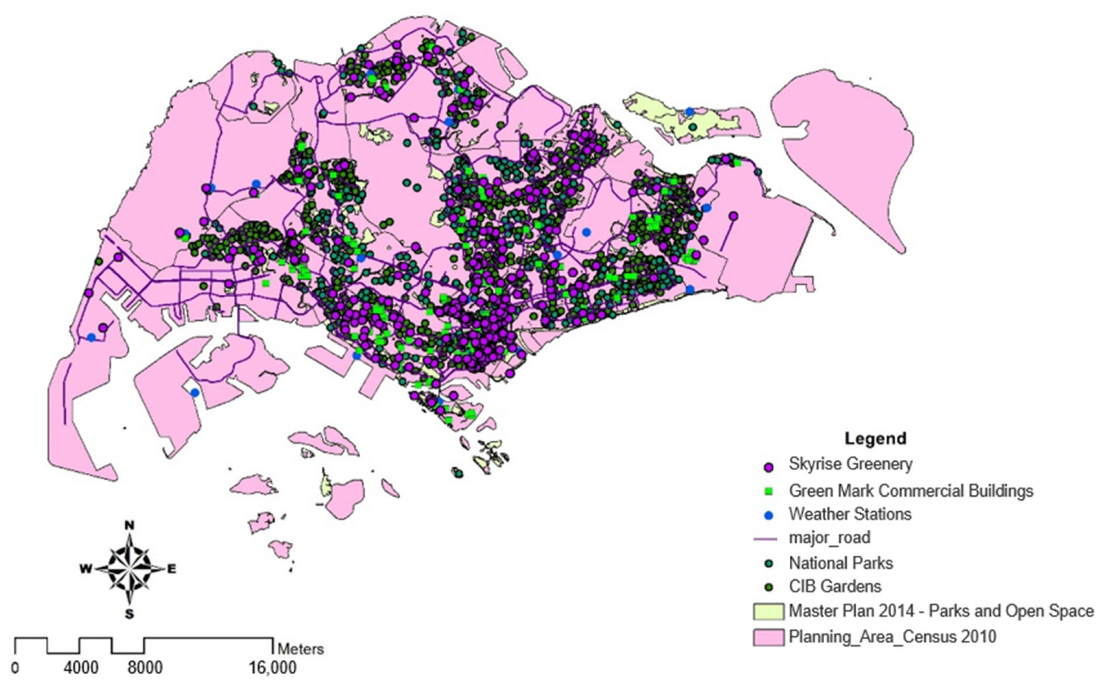

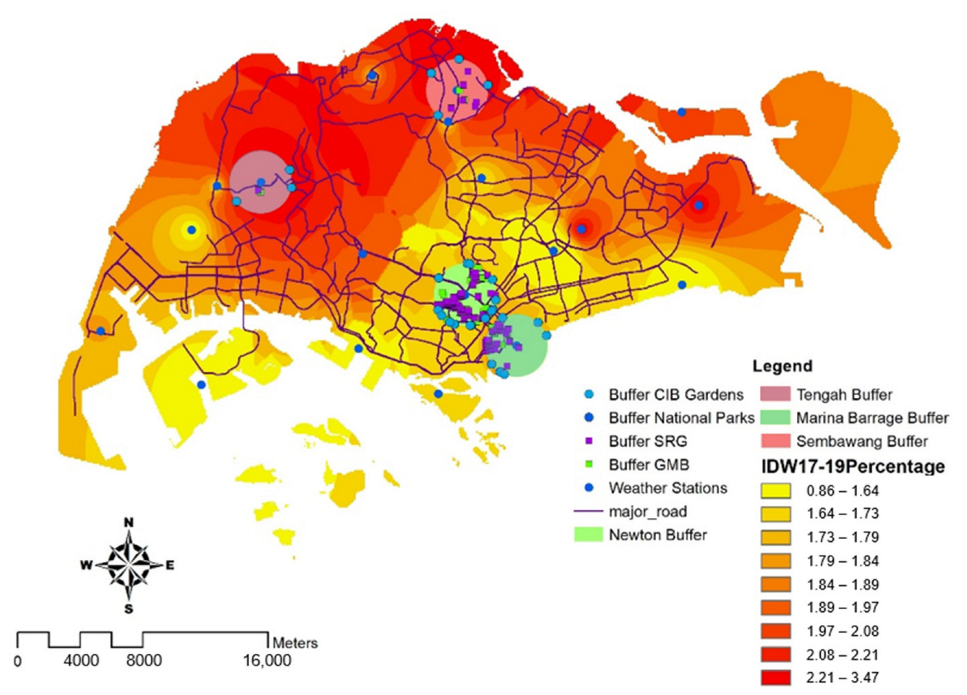
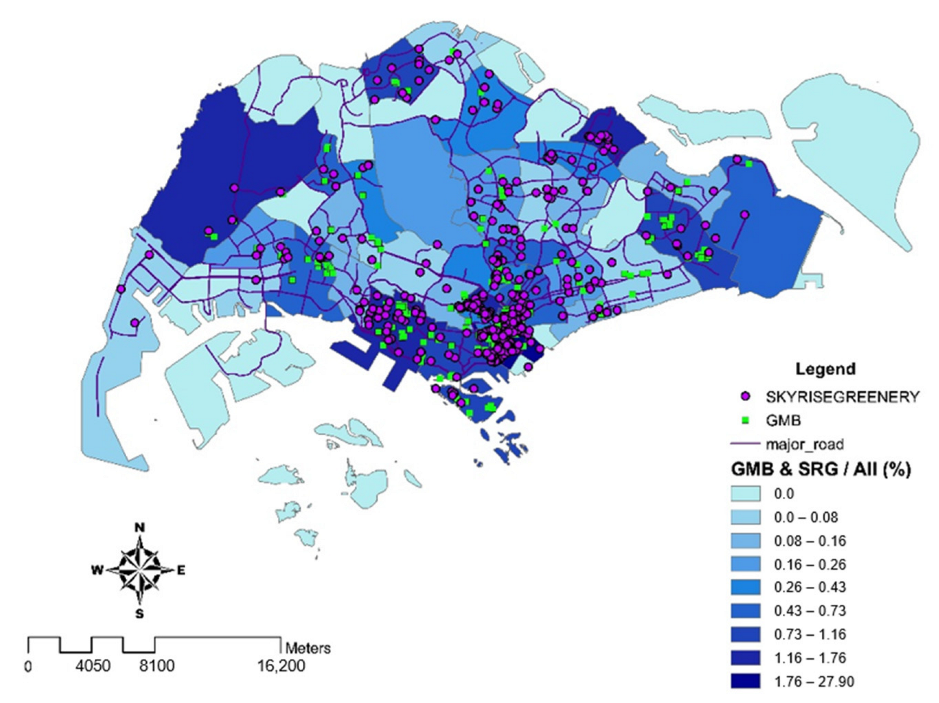
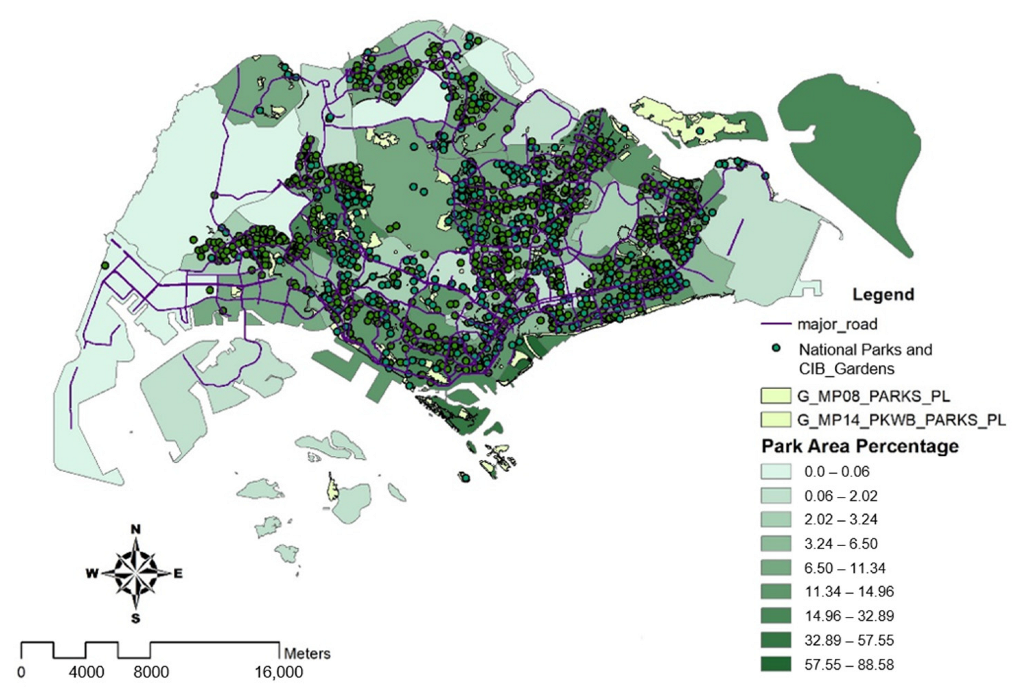
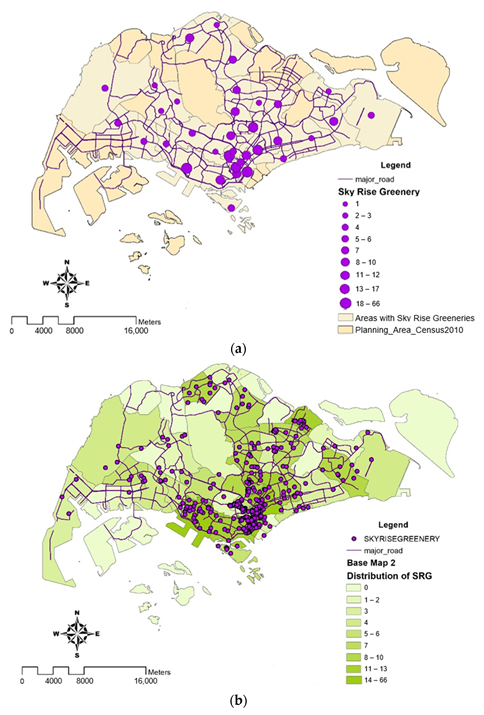
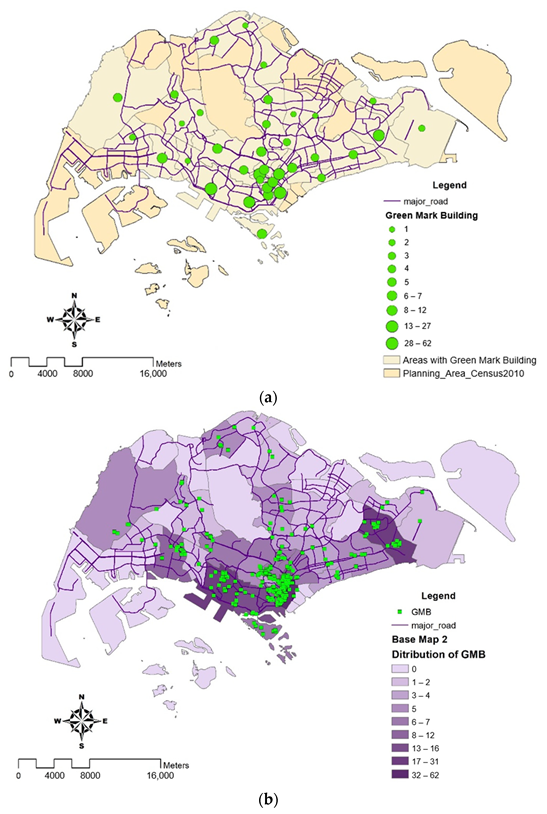
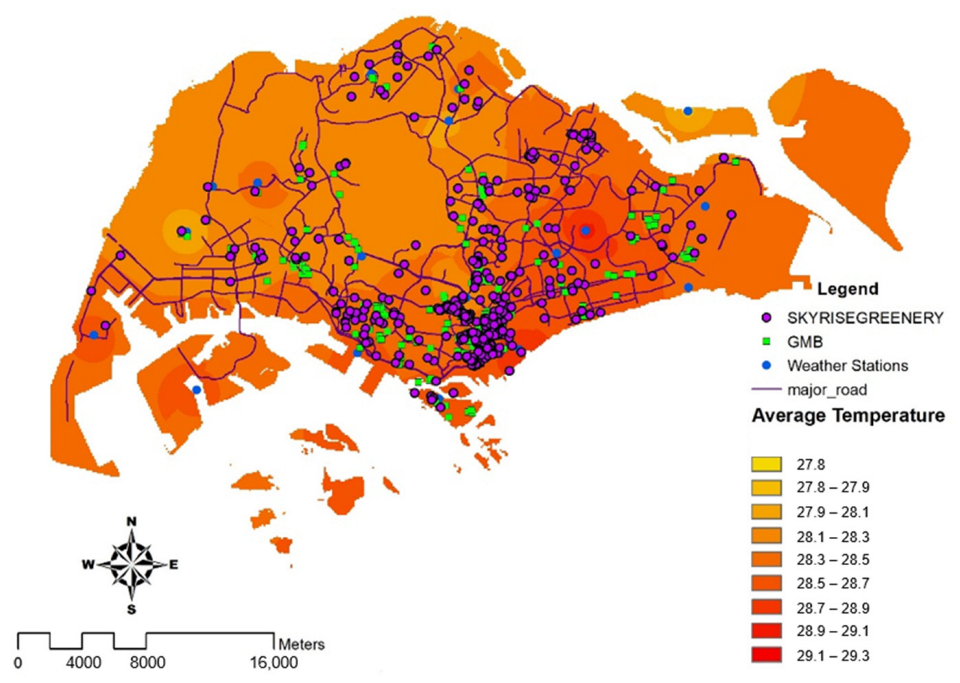
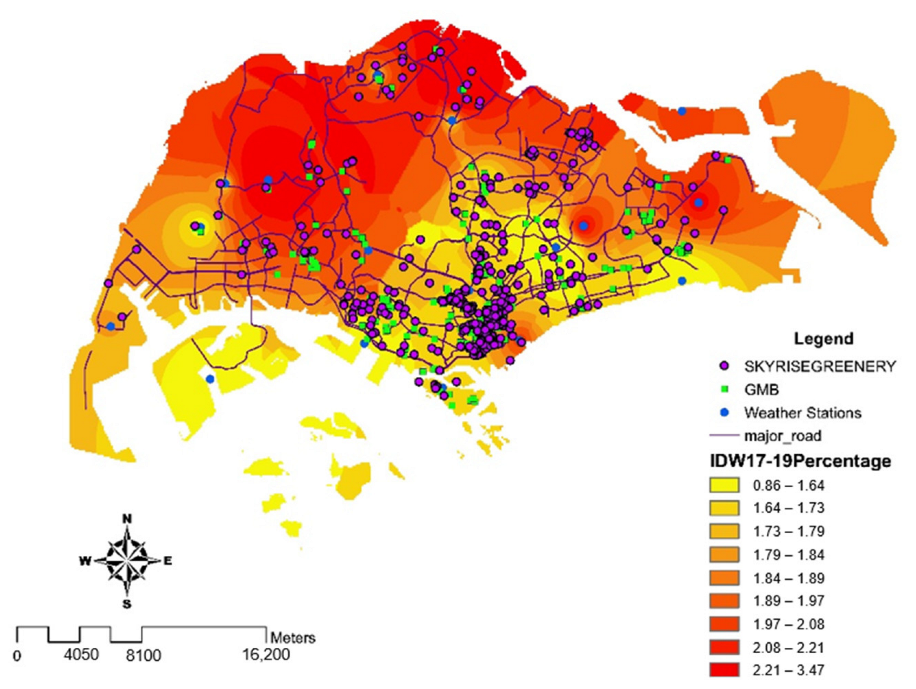
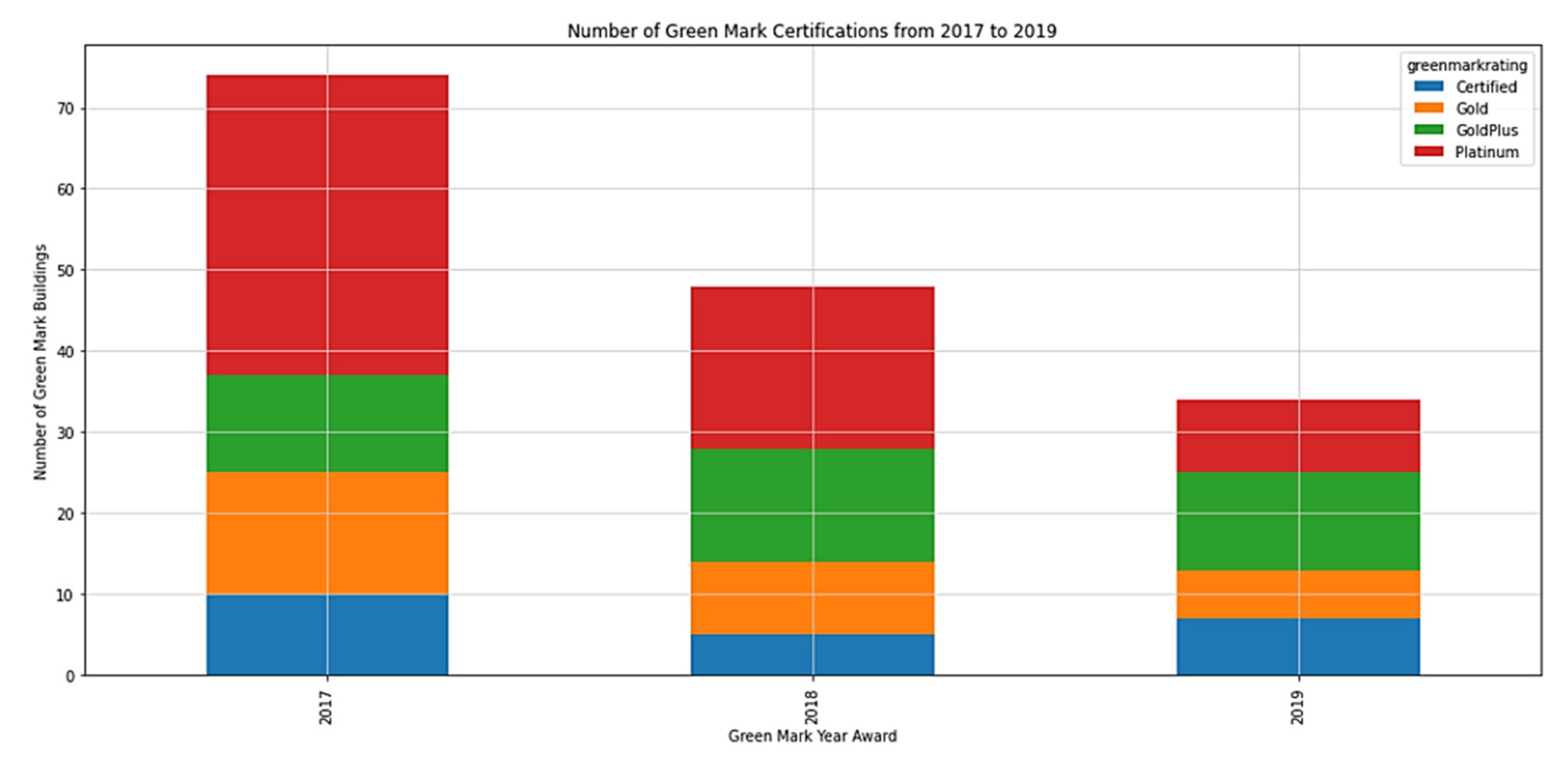
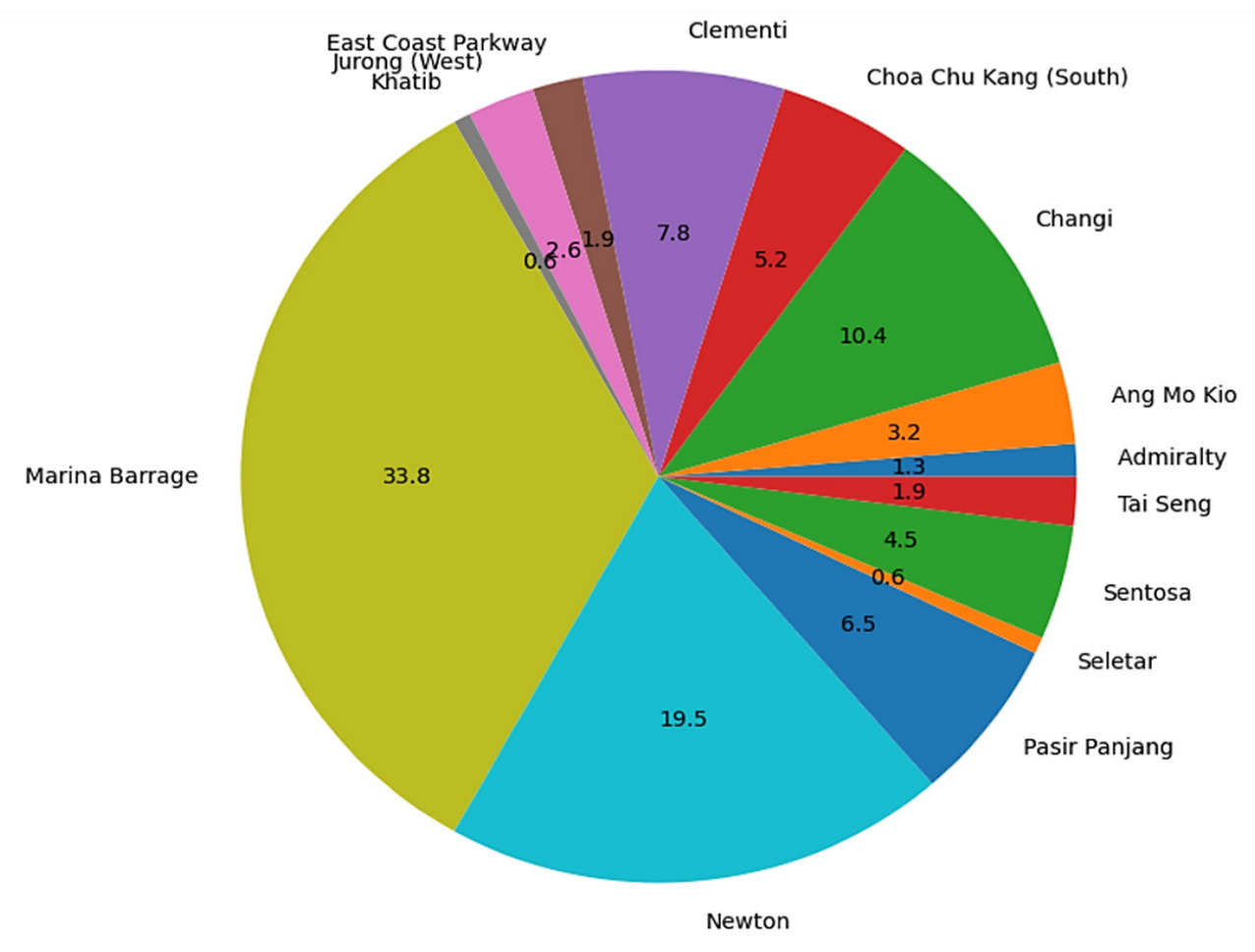

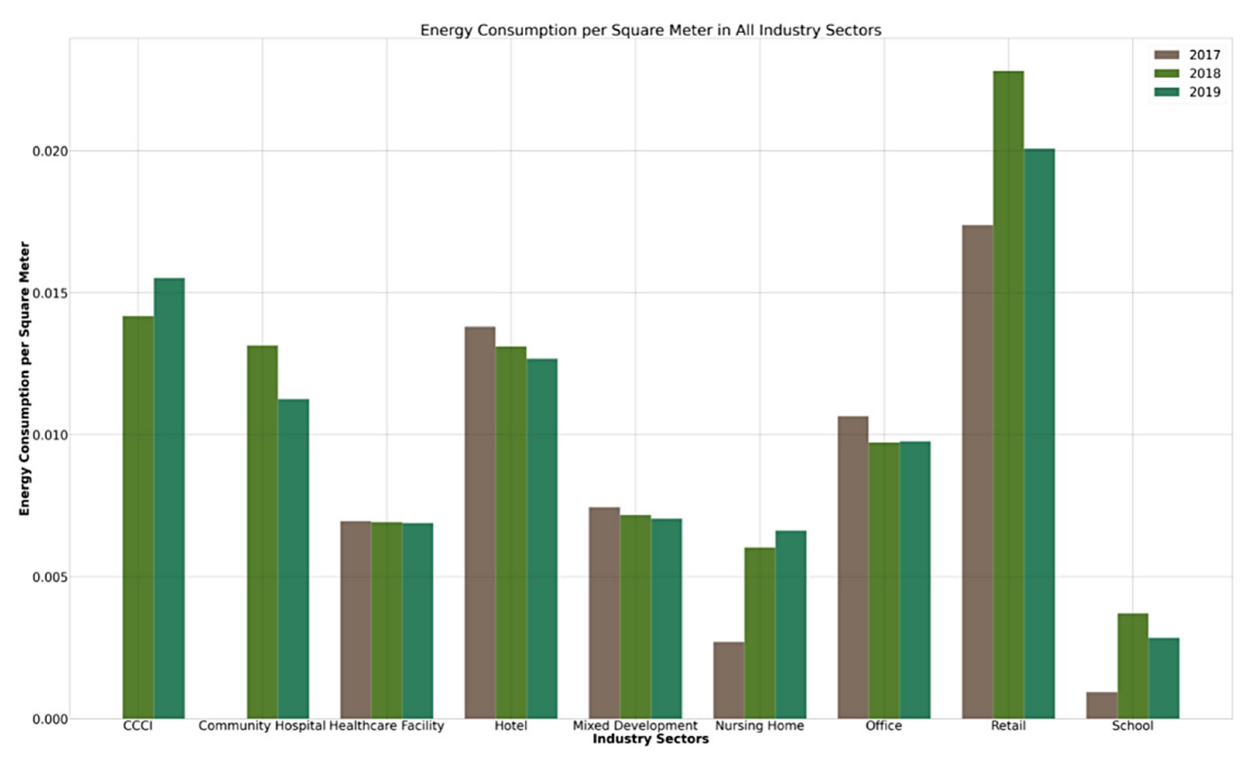
| Which Part of Asia? | Examples of Countries | Current UHI and/or Climate Change Situation | Consequences If No Action Is Taken by 2050 to Reduce UHIs and/or Climate Change |
|---|---|---|---|
| Frontier Asia |
|
|
|
| Emerging Asia |
|
|
|
| Developed Asia |
|
|
|
| Green Mark Certification Rating Categories | Energy Efficiency |
| Water Management | |
| Material and Waste Management | |
| Environmental Planning | |
| Green Buildings and Transport Infrastructure | |
| Community and Innovation |
| Locations of Weather Stations | Average Temperature (°C) |
|---|---|
| Changi | 28.4 |
| Paya Lebar | 29.1 |
| Tengah | 28.6 |
| Seletar | 28.8 |
| Sembawang | 28.4 |
| Tai Seng | 28.5 |
| Jurong (west) | 27.8 |
| Clementi | 28.1 |
| Sentosa Island | 28.6 |
| Admiralty | 28.1 |
| Pulau Ubin | 27.8 |
| East Coast Parkway | 28.4 |
| Marina Barrage | 29.0 |
| Ang Mo Kio | 28.2 |
| Newton | 28.0 |
| Tuas South | 28.6 |
| Pasir Panjang | 28.6 |
| Jurong Island | 28.7 |
| Choa Chu Kang (South) | 28.1 |
| Khatib | 27.9 |
| Building Name | Green Mark Award | Energy Use Intensity | ||
|---|---|---|---|---|
| 2017 | 2018 | 2019 | ||
| Khoo Teck Puat Hospital | Platinum | 311 | 311 | 318.8 |
| Yishun Community Hospital | Platinum | 203 | 209 | - |
| Northpoint City | Gold | 468 | 594 | 587.7 |
| Green Mark Award | Hotel | Retail | Office |
|---|---|---|---|
| GoldPlus | 31.8% | 22.6% | 27.7% |
| Platinum | 36% | 35% | 43.1% |
Publisher’s Note: MDPI stays neutral with regard to jurisdictional claims in published maps and institutional affiliations. |
© 2022 by the authors. Licensee MDPI, Basel, Switzerland. This article is an open access article distributed under the terms and conditions of the Creative Commons Attribution (CC BY) license (https://creativecommons.org/licenses/by/4.0/).
Share and Cite
Teo, Y.H.; Makani, M.A.B.H.; Wang, W.; Liu, L.; Yap, J.H.; Cheong, K.H. Urban Heat Island Mitigation: GIS-Based Analysis for a Tropical City Singapore. Int. J. Environ. Res. Public Health 2022, 19, 11917. https://doi.org/10.3390/ijerph191911917
Teo YH, Makani MABH, Wang W, Liu L, Yap JH, Cheong KH. Urban Heat Island Mitigation: GIS-Based Analysis for a Tropical City Singapore. International Journal of Environmental Research and Public Health. 2022; 19(19):11917. https://doi.org/10.3390/ijerph191911917
Chicago/Turabian StyleTeo, Ya Hui, Mohamed Akbar Bin Humayun Makani, Weimeng Wang, Linglan Liu, Jun Hong Yap, and Kang Hao Cheong. 2022. "Urban Heat Island Mitigation: GIS-Based Analysis for a Tropical City Singapore" International Journal of Environmental Research and Public Health 19, no. 19: 11917. https://doi.org/10.3390/ijerph191911917
APA StyleTeo, Y. H., Makani, M. A. B. H., Wang, W., Liu, L., Yap, J. H., & Cheong, K. H. (2022). Urban Heat Island Mitigation: GIS-Based Analysis for a Tropical City Singapore. International Journal of Environmental Research and Public Health, 19(19), 11917. https://doi.org/10.3390/ijerph191911917







